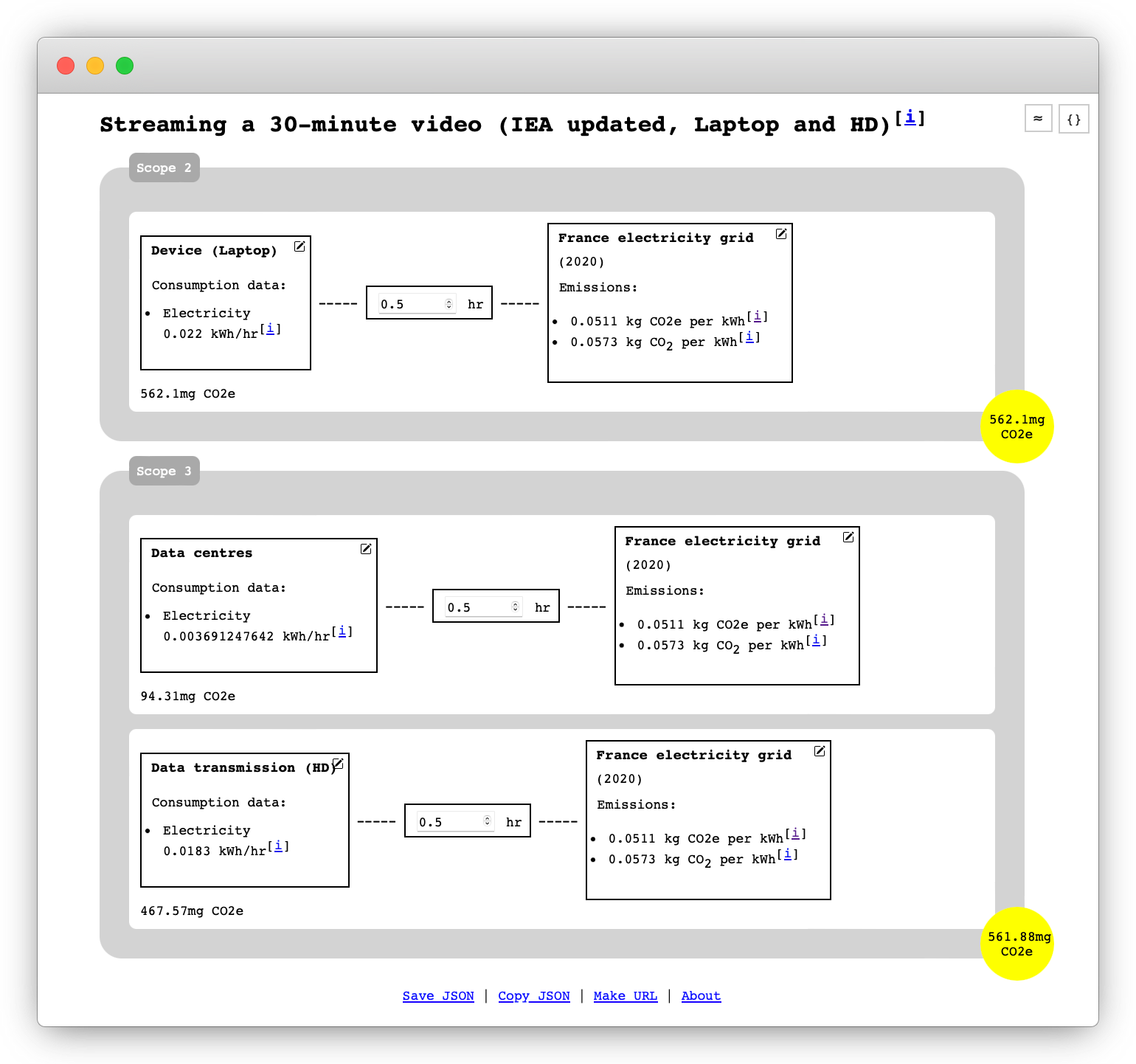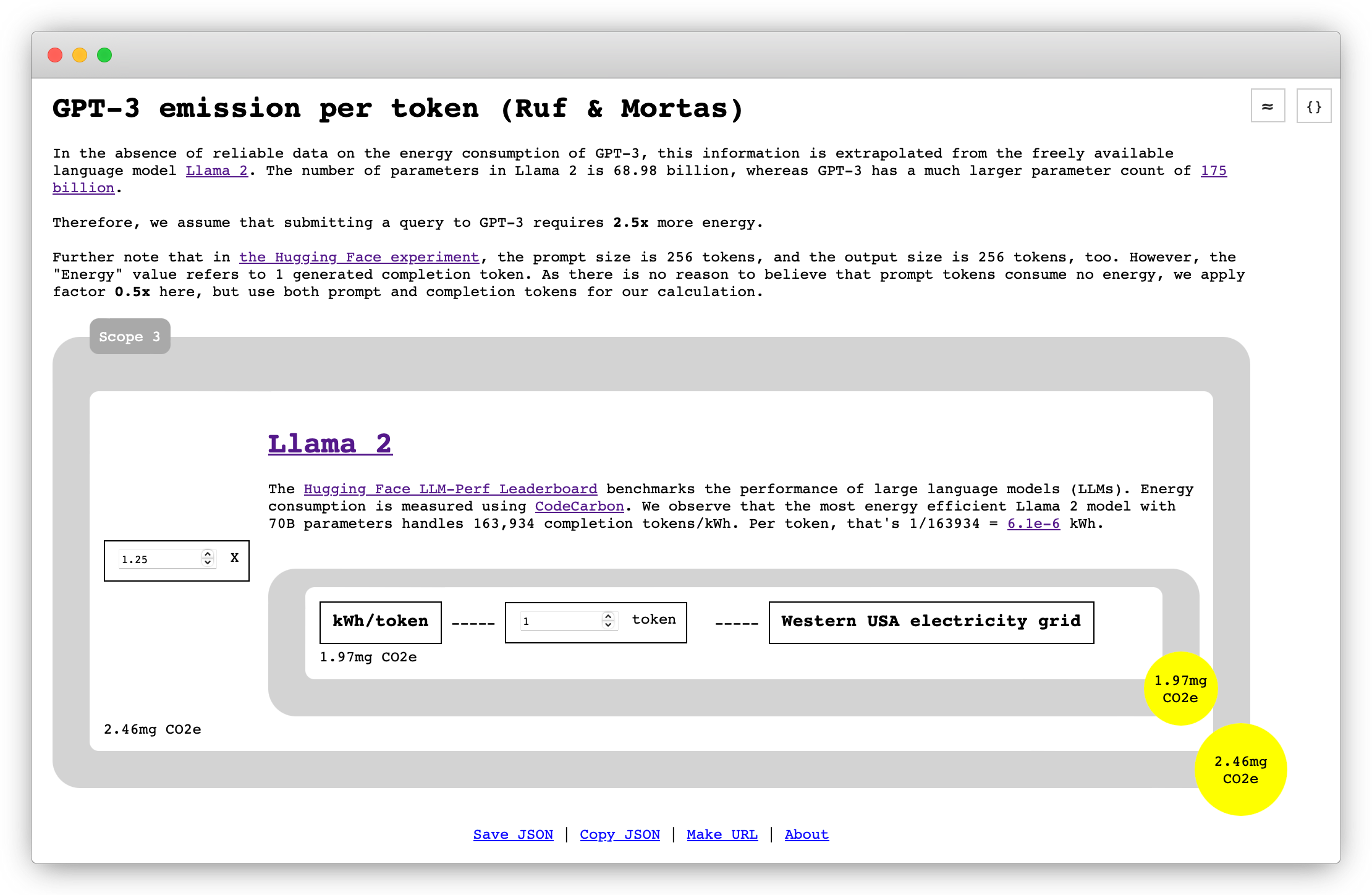A data model and a viewer for carbon footprint scenarios. This toolkit makes it easy to create, share and compare emission scenarios. Its purpose is to improve data quality and transparency in the field of carbon footprint quantification.
The main features of the data model are:
- A universal data scheme to model carbon emission scenarios, split by scopes, consumer components and energy sources
- A modular structure which allows for nested scenarios that can be explored and modified at different levels of detail
- Support to back consumption and emission details with reference sources for better transparency
The main features of the viewer are:
- Automated unit conversion and common emission type detection to avoid data conversion errors
- Editable input fields for quantities to quickly test the effect of different settings
- Possibility to include different data sources for consumer components and energy sources
- One-click data export in the form of file download and scenario sharing via encoded URL
- Easy deployment: No-deployment using encoded URLs, or as serverless application (i.e. on GitHub)
The viewer renders the scenario data which is either stored in a JSON file that is hosted on the server, or it is embedded in the URL.
Details on consumption and emissions can be toggled by clicking on the respective title. If a data source was included, consumer components
or energy sources can be changed by clicking the pencil icon . The total of the emissions per scope is shown in the yellow circle on the bottom right. It is updated instantly when settings in the scenario change. The emissions of nested scenarios are calculated recursively.
- Streaming a 30-minute video [IEA updated, UK] (source)
- Streaming a 30-minute video [IEA updated, Laptop and HD] (source)
- Singapore (SIN) to Paris (CDG) round-trip (source)
- Nested sample of personal carbon footprint (source)
- Cargo ship emissions portfolio (source)
- Monthly operation of ChatGPT
- OpenAI GPT-3.5
- OpenAI GPT-4
- OpenAI GPT-4o
- OpenAI GPT-4o-mini
- Meta Llama 2 7B
- Meta Llama 3 8B
- Mistral 7B
- Mistral Small
- Mistral Large 2
- Falcon 7B
- Falcon 180B
source_idoverwrites all sources in the scenario with the provided source. Example: index.html?id=mistral-small-ruf-mortas-token&source_id=electricity-ireland-2020emission_typesets the emission measure used in the scenario. Example: index.html?id=scenario-8f35af7c-ee5b-42aa-b538-371b126b3d24&emission_type=co2show_consumptionadditionally displays the consumption. Example: index.html?id=scenario-615e4199-28fe-43d4-8b30-3cee5fe18923&show_consumption=true
There are two ways to compose new scenarios: Either by customizing an existing scenario in the viewer and exporting the new setting, or by writing the data structure formatted in JSON from zero.
You can modify an existing scenario as follows:
- Update the quantities, consumer components and energy sources in the user interface (as described above)
- Click the link "Edit data" in the footer and modify the JSON code
When finished, you can do one of the following to export the scenario:
- Click the link "Edit data" in the footer and copy the JSON code
- Click the link "Share via link" and copy the URL of your scenario
Create a new JSON file following the data scheme. For example:
{
"title": "Mobility",
"scopes": [
{
"level": "Scope 1",
"description": "'on-site' direct emissions",
"list": [
{
"type": "component",
"consumer": {
"name": "Volkswagen Golf (2014)",
"description": "Engine ID 45, 4 cylinders, Manual 6-spd",
"consumptions": {
"diesel": {
"value": "0.0735046875",
"unit": "l",
"base_unit": "km",
"reference_url": "https://www.fueleconomy.gov/"
}
}
},
"quantity": "10000",
"quantity_unit": "km",
"source": {
"name": "Gas/Diesel oil",
"type": "diesel",
"description": "",
"emissions": {
"co2e": {
"value": "3.25",
"unit": "kg",
"base_unit": "l",
"reference_url": "https://bilans-ges.ademe.fr/documentation/UPLOAD_DOC_EN/index.htm?new_liquides.htm"
}
}
}
}
]
}
]
}Assign a random identifier as file name and upload it to the "scenarios" folder of the application. Load the scenario by providing the identifier (without the .json file extension) as id parameter in the URL. Example: index.html?id=scenario-95e1ade0-033c-40de-b30d-4e62f4723254
Carbon emission scenarios are complex and interconnected. Consequently, the data model supports scenario nesting via links. For example:
{
"title": "GPT-3",
"description": "In the absence of reliable data on the energy consumption of GPT-3, this information is extrapolated from the freely available language model <a href=\"https://huggingface.co/meta-llama/Llama-2-70b-hf\" target=\"_blank\">Llama 2</a>. The number of parameters in Llama 2 is 68.98 billion, whereas GPT-3 has a much larger parameter count of <a href='https://openai.com/research/language-models-are-few-shot-learners' target='_blank'>175 billion</a>.<br/><br/>Therefore, we assume that submitting a query to GPT-3 requires <b>2.5x</b> more energy.",
"scopes": [
{
"level": "Scope 3",
"description": {},
"list": [
{
"type": "link",
"quantity": 2.5,
"scenario_id": "llama2-7b-token"
}
]
}
]
}The viewer loads all nested scenarios recursively into a single, interactive scenario:
The benchmark view renders a bar chart for two or more hosted scenarios identified in the URL by their ids, like benchmark.html?scenario_ids[]=scenario-1&scenario_ids[]=scenario-2.
Use the benchmark form as a starting point.
titleadds a title to the benchmark view.factoris a multiplier which is applied to all scenarios.reference_idsputs the scenario into perspective with one or more other scenarios. Example: benchmark.html?scenario_ids[]=gpt-ruf-mortas-1&factor=1000&title=1,000%20ChatGPT%20requests&reference_ids[]=dieselreferencetakes an encoded scenario as reference (mind the maximum number of url characters supported by your browser).
The search view can be accessed either by directly visiting search.html or by clicking on the link "Contextualize emissions" in the footer of any scenario. In the search bar, an emission value, the type of mass, and the emission category can be specified. The search results display comparable carbon scenarios for different scales: identical emissions, 10 times, 100 times, and 0.1 times.
The index.js file functions as (flat-file) database, produced by the Node.js script create-index.js (please note that the rest of the code does not depend on Node.js!).
This is a fully functional prototype, more features are in the planning. Any feedback is welcome.
B. Ruf and M. Detyniecki, "Open and Linked Data Model for Carbon Footprint Scenarios", 7th International Conference on Renewable Energy and Conservation (ICREC), 2022.
I. D'Aramon, B. Ruf, M. Detyniecki, "Assessing Carbon Footprint Estimations of ChatGPT", 8th International Conference on Renewable Energy and Conservation (ICREC), 2023.
B. Ruf, Félix Mortas, M. Detyniecki, "Transparent and Human-centered Carbon Footprinting", 42nd ACM Conference on Human Factors in Computing Systems (CHI), Workshop on Sustaining Scalable Sustainability, 2024.
Copyright (c) Boris Ruf
Permission is hereby granted, free of charge, to any person obtaining a copy of this software and associated documentation files (the "Software"), to deal in the Software without restriction, including without limitation the rights to use, copy, modify, merge, publish, distribute, sublicense, and/or sell copies of the Software, and to permit persons to whom the Software is furnished to do so, subject to the following conditions:
The above copyright notice and this permission notice shall be included in all copies or substantial portions of the Software.
THE SOFTWARE IS PROVIDED "AS IS", WITHOUT WARRANTY OF ANY KIND, EXPRESS OR IMPLIED, INCLUDING BUT NOT LIMITED TO THE WARRANTIES OF MERCHANTABILITY, FITNESS FOR A PARTICULAR PURPOSE AND NONINFRINGEMENT. IN NO EVENT SHALL THE AUTHORS OR COPYRIGHT HOLDERS BE LIABLE FOR ANY CLAIM, DAMAGES OR OTHER LIABILITY, WHETHER IN AN ACTION OF CONTRACT, TORT OR OTHERWISE, ARISING FROM, OUT OF OR IN CONNECTION WITH THE SOFTWARE OR THE USE OR OTHER DEALINGS IN THE SOFTWARE.




